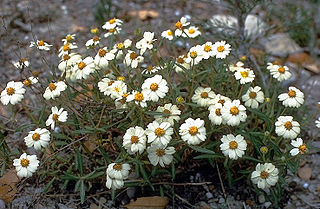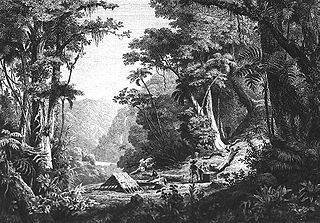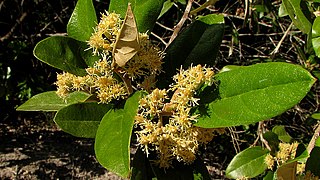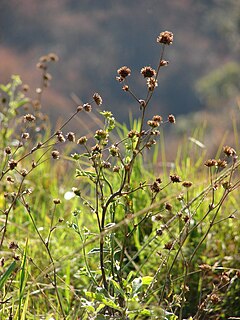
The Atlantic Forest is a South American forest that extends along the Atlantic coast of Brazil from Rio Grande do Norte state in the northeast to Rio Grande do Sul state in the south and inland as far as Paraguay and the Misiones Province of Argentina, where the region is known as Selva Misionera.

Bahía Blanca is a city in the southwest of the province of Buenos Aires, Argentina, by the Atlantic Ocean, and is the seat of government of Bahía Blanca Partido. It had 301,572 inhabitants according to the 2010 census [INDEC]. It is the principal city in the Greater Bahía Blanca urban agglomeration.

Melampodium is a genus of flowering plants in the sunflower family.

Grindelia (gumweed) is a genus of plants native to the Americas belonging to the family Asteraceae. The genus was named for Latvian botanist David Hieronymus Grindel, 1776–1836.

Cnidoscolus is a plant genus of the family Euphorbiaceae first described as a genus in 1827. The group is widespread across much of North and South America, including the West Indies.

Hugh Algernon Weddell was a physician and botanist, specialising in South American flora.

Cosmos sulphureus is a species of flowering plant in the sunflower family Asteraceae, also known as sulfur cosmos and yellow cosmos. It is native to Mexico, Central America, and northern South America, and naturalized in other parts of North and South America as well as in Europe, Asia, and Australia.

The Rosario and Puerto Belgrano Railway was a French-owned railway company which operated a 5 ft 6 in broad gauge, 5 ft 6 in, single track line between the cities of Rosario and Puerto Belgrano in Argentina. Puerto Belgrano, near the city of Bahía Blanca in Buenos Aires Province, is the main naval base in Argentina. The original idea behind the building of the railway was to link points that were closer to either Rosario or Bahía Blanca than they were to Buenos Aires, thereby taking traffic from the British-owned companies BA Great Southern and BA Western railways.

The plushcap is a species of bird in the tanager family Thraupidae and it is the only member of the genus Catamblyrhynchus.

The southern tuco-tuco is a species of rodent in the family Ctenomyidae. It is endemic to Argentina.

The Gochnatioideae are a subfamily of the aster family, Asteraceae. It contains the single tribe Gochnatieae of six genera, with a total of about 80 to 90 species. They are native to the Americas from the southern United States to Argentina, including the Caribbean, and Cuba in particular.
The South American land mammal ages (SALMA) establish a geologic timescale for prehistoric South American fauna beginning 64.5 Ma during the Paleocene and continuing through to the Late Pleistocene. These periods are referred to as ages, stages, or intervals and were established using geographic place names where fossil materials where obtained.
The Deseadan age is a period of geologic time within the Oligocene epoch of the Paleogene to the Early Miocene epoch of the Neogene, used more specifically within the SALMA classification of South America. It follows the Tinguirirican and precedes the Colhuehuapian age.
The Laventan age is a period of geologic time within the Middle Miocene epoch of the Neogene, used more specifically within the SALMA classification in South America. It follows the Colloncuran and precedes the Mayoan age.
The Chasicoan age is a period of geologic time from 10–9 Ma within the Late Miocene epoch of the Neogene, used more specifically within the SALMA classification in South America. It follows the Mayoan and precedes the Huayquerian age.

Homolepis is a genus of Neotropical plants in the grass family. They are native to Mexico, Central and South America, and the West Indies.

Melanthera, squarestem, is a genus of flowering plants in the family Asteraceae, native to North and South America, as well as Africa, Asia and Oceania, including Hawaiʻi.

Cnicothamnus is a genus of flowering plants in the family Asteraceae. Its species are small trees which can reach 5m in height, bearing alternate ovate and dentate leaves with a whitish pubescence. The inflorescences, borne at branch tips, are bell-shaped capitula of a bright orange colour, and usually appear during local winter. Their fruit bears a rough plume.

Elephantopus mollis, common names tobacco weed, and soft elephantsfoot, is a tropical species of flowering plant in the sunflower family.















